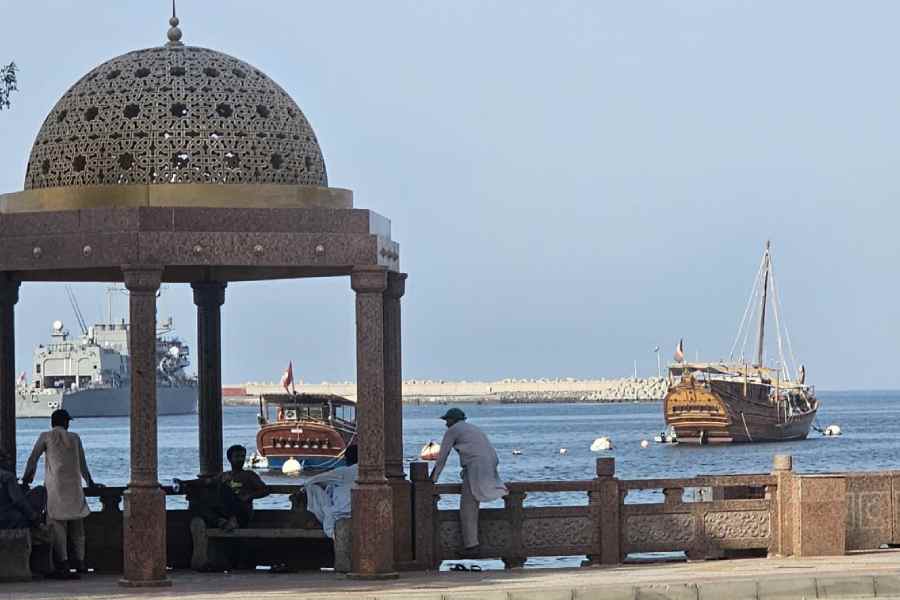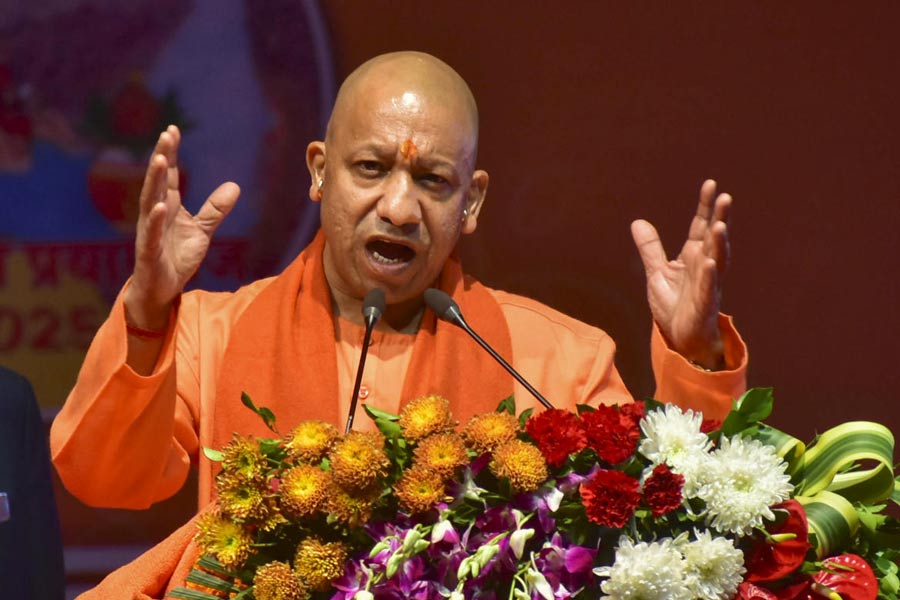Feluda would not approve. That was the dismaying thought in my head as I settled in the Oman Air flight headed for Muscat. Indeed, Satyajit Ray’s sleuth, idolised by every youngster growing up on Bengali literature, would read up voraciously on the destination before a journey. But saddled as I was with everyday work, there was simply no time to research Oman. Country in Arabian peninsula. Ergo desert — dry and hot. That’s all I thought when I had packed.
So while waiting to collect the luggage by the belt, when an Oman Tourism official asked me: “Hope you have brought swimwear,” my eyes popped out.

Alila Jabal Akhdar resort on the canyon
“Er, no. Why?”
“You are going snorkelling tomorrow,” he replied, assuring me that I wouldn’t need any winterwear there. His stress on the last word made me suspicious and I asked if winterwear would be needed anywhere at all.
“Oh, just light woollens for the nights you spend in the mountains,” he smiled, as I was thrown off my stride one more time.
Within an hour of landing in Muscat, my preconceived notion about the nation’s topography had been sent for a toss.
Oman, despite being smaller than Rajasthan, I found out belatedly, has a wealth of variety in its landscape — valleys, desert, mountains, coastal plain — but all that can be packed into a week’s trip. And it’s less than three hours by flight from Mumbai. Or one can take Emirates from Calcutta and hop over via Dubai.
Muscat, the capital, is striking in its lack of colour and height. The buildings are spread out, short and mostly white, like the flowing dishdashah worn by the men. The choice of colour makes sense as it does not absorb heat. “Tall buildings are banned by royal decree,” our guide Toobi explained.
A quick research on the Net unearthed the government’s stance against “bland urbanism”, as voiced by Sultan Bin Hamdoon Al Harthy, chairman of Muscat Municipality. While the colours have to be “modest and earthy so that they respond well with nature’s colours”, buildings in Muscat cannot rise over 40m. “We do not want skyscrapers to compete with our mountains,” he has said. The edict came in force after the 14-storied Sheraton Oman was built in 1985, making the hotel the tallest structure in the city.
A drive up and down the wide undulating roads takes one through slate-coloured hillocks, often lined by palm trees. The high court compound on the wayside looks surprisingly deserted. “Oman is a peaceful country. There is hardly any crime. Even poor people drive their own cars. The majority have houses too. There is no personal income tax. Once an Omani turns 23, he can apply for land to the government under the social housing project,” Yasser, our driver, says as we, the Indian group members, exchange silent glances.
Sultan Qaboos Road, named after Oman’s former ruler Qaboos bin Said, is the arterial road cutting across the city. “Before he came in 1970, Oman had barely 10km of tarmac roads, three small schools and two hospitals. He pumped in oil money into infrastructure. Any elderly man who remembers how things were before 1970 would say we are living in heaven now,” says Toobi, a bit emotionally. The whole country mourned when the Sultan passed away in 2020 after almost five decades on the throne.
MUTTRAH
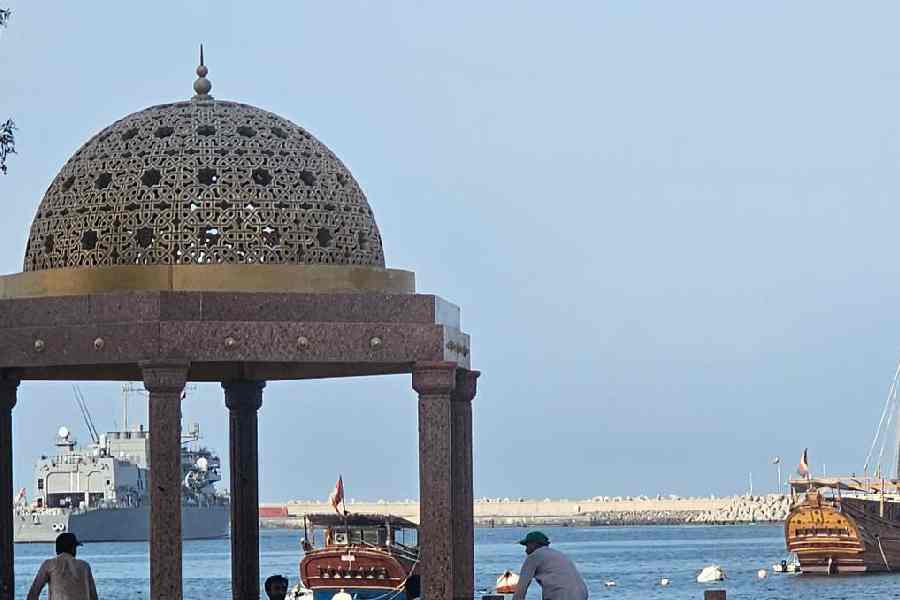
A view of the Gulf of Oman with yachts and dhows from Muttrah souk
We check into Jumeirah Muscat Bay, a serene beach resort set between the dramatic Al Hajar mountains and the sparkling Gulf of Oman. Our destination for the afternoon is Muttrah, on the north-eastern coastline of the city. The trip takes us back in time. The waterside souk (outdoor market) here is almost 200 years old. The shops are shut for asr (afternoon) prayer and we are asked to return at 5pm. We spend the time watching the royal yacht parked in the waters, dwarfing the dhows (teakwood fishing boats). “The dhows are used mostly for tourists now. You can even have a barbecue on board,” our guide says.
The commercial port is strategically located on the sea route to India. “We have onion, garlic, jaggery, clothes and even goats coming by ship,” he smiles. As the clock inches towards 5pm, we head back, stopping at the money-changer’s on the way. One Omani rial is almost Rs 220. Sigh! The souq has an old-world feel, much like New Market. The products are very traditional — dates, frankincense, local clothes, scented soap, ceramic plates.... On the way back, we visit the Al Alam palace, one of the Sultan’s six official residences. Two 16thcentury watch towers at the back are a throwback to the years of Portuguese rule over Oman, from 1507 to 1656.
WATERWORLD
The next morning we set off in a speedboat for the Damaniyat islands, an archipelago of nine uninhabited islands which has been declared a nature reserve. A 40-minute cruise takes us to a tropical paradise with turquoise blue water and a bustling underwater life. It is an active coral reef and snorkelling yields rich dividends. “Hey, there’s a hawksbill turtle up ahead,” someone in our group bobbed up above the water surface, took off the tube momentarily from the mouth and yelled. The rest of us took the lead and swam behind him. We met not one but two turtles, parent and baby, which were not shy of our boat captain’s waterproof camera. Shoals of colourful fish swam by, unmindful of our presence. An hour later, it was only hunger pangs which forced us to return to the boat for lunch.
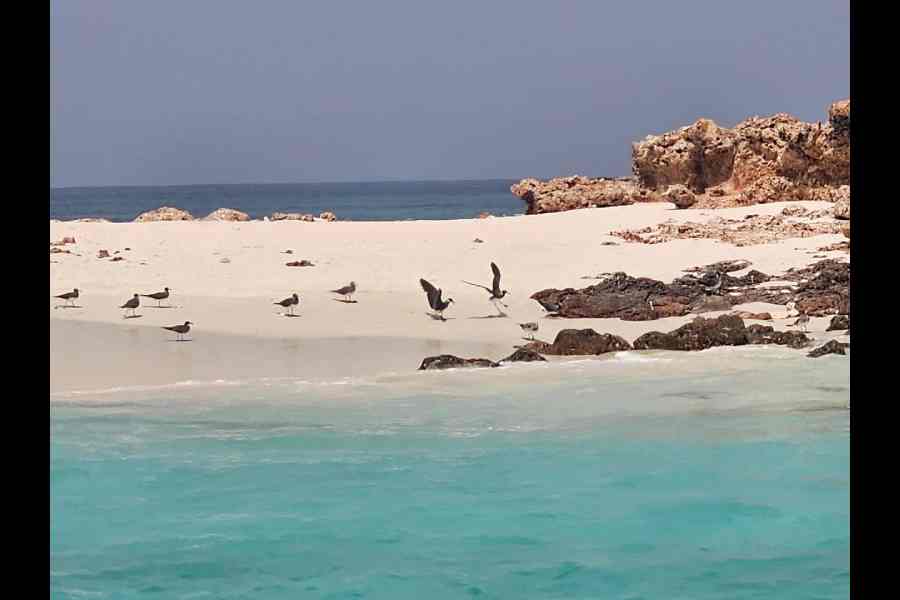
Damaniyat Island
From May to October, landing on the islands is prohibited to protect nesting sites of turtles and migratory birds. “The rest of the year, you can get on the beach, play volleyball, go hiking and even camp overnight. But visibility is better in summer as the water is crystal clear,” said Faisal Ali Azid, who was piloting the boat. The fivehour trip cost 250 OMR per head. “We take a maximum of 20 in a group,” he said. A full day (eight hours) would cost OMR 350 per head, he said.
MUSCAT MONUMENTS
In the afternoon, we headed for the two biggest landmarks of the city — the Royal Opera House and the Grand Mosque. “It is the first opera in an Arab country,” said the lady who guided us through the 80,000sq m property that opened in 2011. Its manicured garden is an oasis amid the arid surroundings just as the opera house has proved to be a cultural oasis in terms of its liberating influence in the Arab world. “The teakwood of the ceiling came from Burma, the marble for the interiors from Italy, the lights from Austria and the design of the balcony that used to separate women audience members from men is Moroccan,” she said. It has hosted global stars like Placido Domingo and Yo-Yo Ma, and tickets are sold out months in advance.
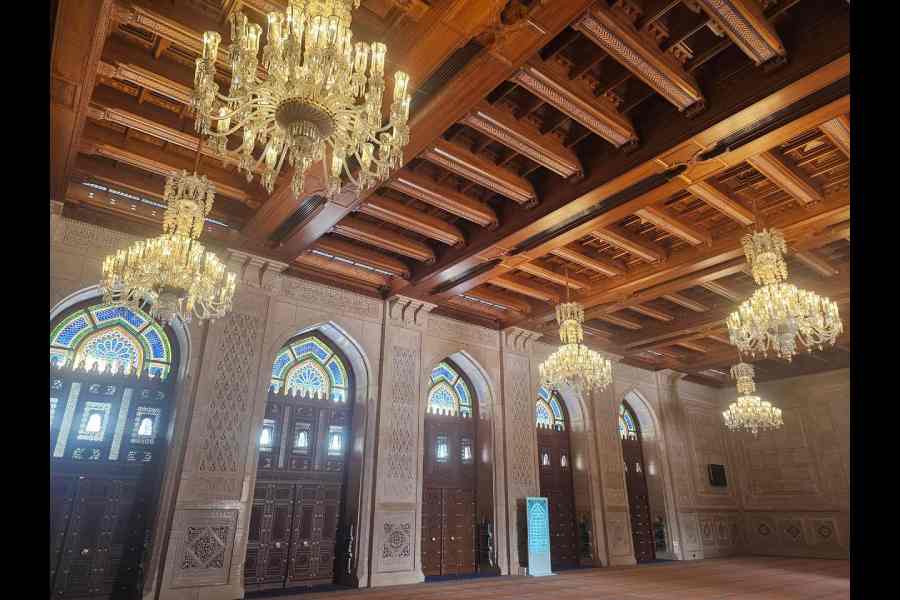
The elaborate interior of the Grand Mosque in Muscat
A permanent exhibition takes visitors on a journey through sounds of nature through the seasons and environments, as also the music of Oman and the world. Interactive tools are used to allow one to understand the science behind the rhythm of heartbeats as also woodwind, string and percussion instruments.
One can also sample works of musicians of the Arab and the Western world through headphones. The Grand Mosque is another of Sultan Qaboos’s gifts to Oman. It took six years and seven months to build, and can accommodate up to 20,000 worshippers in the inner hall and the outer paved ground, including 750 women in a separate enclosure. The mosque has used Indian sandstone, Italian Carrara marble, Iranian ceramic and Burmese teakwood. The carpet in the main prayer hall weighs 21 tonnes and took four years to produce. The gigantic chandelier is 14m tall and features 600,000 Swarovski crystals and 1,122 halogen bulbs. Both the carpet and the chandelier were the largest of their kind till they were outdone by the Sheikh Zayed Mosque in Abu Dhabi.
This is one place where my travel wardrobe was not lacking as I did carry a dupatta to cover my head.
CALL OF THE MOUNTAINS
Jabal Akhdar, our next destination, was three hours away by road from Muscat. Jabal means mountain in Arabic, and this limestone mountain is part of the Hajar range. The higher altitudes receive enough rain to give the area a green cover.
Nestled on the edge of a V-shaped cliff overlooking a canyon, Alila Jabal Akhdar was itself the high point of the trip. The exterior of the property has rocks in place of bricks. “The rocks that were cut out of the mountain when this resort was built were used in its construction,” said general manager Puneet Singh, who joined us for dinner.
With gas-lit flames in torches providing golden yellow illumination at the restaurant and an artificial fountain gurgling by, he talked of the extensive farming done on the property. “We grew 300kg of pomegranates, plums, apricots and olives this year. Pomegranate jam was made in-house. We have 36 bee houses where 90litres of honey was harvested. But an unseasonal rain destroyed our rose garden,” he said.
The hotel creates experiences using the unique locational advantages, be it setting up a spa table outdoors under a canopy at a far end of the cliff or setting up a candle-lit private dinner on a secluded ledge. “We take guests on butterfly walks, on geology walks to explain the rock formations and even down in the village to pluck fruits in the orchard. Families come here to reconnect with nature. You won’t hear a single honk during your stay,” Singh said. Even the water served was bottled from springs on the property, he added.
After dinner, shivering under a full moon, we made our way to a rocky platform where a telescope had been set up to spot planets in the clear night sky. The next morning we made our way downhill to watch terrace cultivation. A walk through the abandoned village of Al Ayn took us within a stone’s throw of pomegranate fields. Collectors walked past us carrying the freshly plucked produce on their heads.
“There are so many orchards in the village at the foothills of our hotel that helicopters are sent to collect the produce. Without road connectivity, it is impossible to carry up the load,” Suman Das, a Murshidabad boy who works at the hotel, later told me, showing a video clip of a helicopter flying up with fruits. It is criminal to stay in bed when the first rays of the sun hit every cliffview room. The walk to the morning yoga session venue revealed myriad shades of the canyon rockface as the horizon changed hue. “In winter, visibility reduces so much that the mountains vanish behind a veil and the clouds descend so low that you can touch them,” said Miraj Khan, a Bangladeshi gardener who showed me around the fields.
YELLOW WILDERNESS
Our last night on the trip was to be spent in the desert. As we approached the Wahiba sands, as a precaution, the air pressure of the car tyres was reduced. This, we were told, would provide better traction and prevent the vehicle from getting stuck in the sand. Stepping into the air-conditioned tent that housed the reception of Desert Night Camp, we were advised to book our camel rides quickly to witness the impending sunset. But our driver took us aside and offered to take us in the car itself to the sunset point at a cheaper rate. Undecided about the choice, I walked towards two camels seated just outside the tent, munching away. I cosied up to one and tried taking a selfie together. It bared its ample teeth, flared its nostrils and sneezed, sending a panic-stricken me lunging away in reflex action. Suddenly the car seemed a more docile option as a mount. Standing in the middle of the desert with sand stretching up to the wilderness bathed in orange glow of the setting sun makes some people philosophical.
For others, it is an unending photo and video opportunity, the drama of the moment heightened by the patterns crafted by the wind on the undulating sand dunes. Our car’s tyres added their imprint too. For miles on end, there seemed to be nothing in sight to interrupt the sandy terrain except the rare thorny bush, but a 1986 expedition by the Royal Geographical Society had documented the flora and fauna of the Wahiba sands, noting 16,000 invertebrates and 200 species of other wildlife. On the way back, our driver noticed another car with its rear tyre trapped in the sand and we stopped to help it out. By the time the vehicle budged, it was pitch dark and there were shadowy figures scrurrying across the sand under our car’s headlights as we made our way back to the camp. The survey then made sense.
Our rooms were in luxury tents scattered across the walled compound. The camp manager said they could serve dinner for over a hundred guests in the desert, complete with bonfire, belly dance and a fire-eater’s show. Given we were 95 short of the number, we settled for the spread in the dinner tent that ended in Umm-ali, my favourite dessert by now, with layers of crispy puff pastry baked in sweet milk with nuts, raisins, and coconut. Outside, Omani musicians sang soulful ditties, playing the oud. On spotting Indians in the audience, they broke into Tumhe dekha toh yeh jana sanam from Dilwale Dulhaniya Le Jayenge.
Shah Rukh Khan is a passport that crosses borders! The next morning some of our group went dune-bashing in ATVs. It was quite a sight to watch ATVs ride in a file into the horizon, raising a cloud of sandy dust, but I preferred to use the time to pack. Back in Muscat, our last stop was the Mall of Oman, spread over 140,000sq m in three levels. The indefatigable ones shopped, with an eye for discounts on brands. For me, it turned out to be a great location to speed walk in a bid to shed the sins accumulated at the dessert counter before boarding the flight home.

